Op woensdag 9 augustus 2006 hielden de Vrienden
van het In Flanders Fields Museum een Remembrance te
Zillebeke. Deze herdenkingen hebben tot doel elk jaar enkele
gesneuvelden te huldigen op de datum van hun overlijden.
Zo willen ze de vele anonieme namen op de gedenkstenen een
"gezicht". Men luistert naar het persoonlijke
verhaal en betuigt zijn respect door een kransnederlegging
en het spelen van de Last Post.
The aim of these remembrances is to mark our respect
to some of the fatal casualties on the date of their death.
Therefore the numerous anonymous names on the headstones
are personalised. We listen to his (or her) personal history
and pay our respect by laying a wreath and playing the Last
Post.
Woensdag 9 augustus 2006 om 19.00 u.:
Henry White
Private No. 717 8th Durham Light Infantry
+ Killed in action 9 August 1915
Ploegsteert
Memorial, Ploegsteert
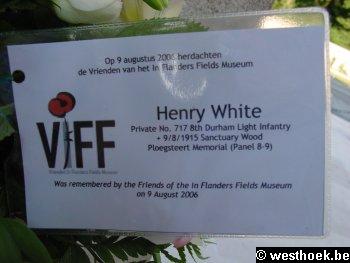
Toelichting bij het leven van Henry White door Gilbert
Ossieur.
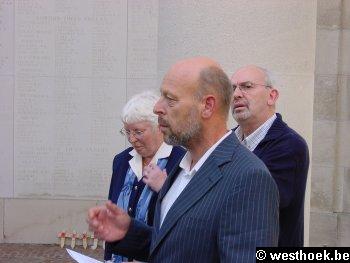
Private Henry White werd geboren in februari 1891, in Greencroft,
County Durham. Hij was de tweede zoon van Annie en Ernest
White, een mijnwerker. Henry ging vanaf zijn 12 jaar werken
in de mijn.
Op 17-jarige leeftijd trad hij toe tot de Territorial Defence
Force als gewoon soldaat. Hij was 1,65 m. groot en diende
bij de 'E' Company in the Drill Hall te West Pelton, bij
Chester-le-Street.
Hij zette zijn dienst verder bij de Territorials, trainde
in de weekends en tijdens jaarlijkse kampen tot aan de oorlogsverklaring
op 4 augustus 1914. Toen werd zijn bataljon en divisie onder
de wapens geroepen en nam verdedigende posities in aan de
noord-oost kust van Engeland. De training werd opgedreven
en ze werden beter uitgerust, tot de divisie voor de dienst
opgeroepen werd naar het continent in april 1915.
Het bataljon kwam aan in Boulogne op 20 april 1915 en begaf
zich naar de Divisional Assembly Area rond Cassel/Steenvoorde.
Het was de bedoeling dat de divisies hier zouden trainen
en zich voorbereiden om de Britse eenheden in de loopgraven
te vervoegen.
Evenwel, op 22 april 1915 gebruikten de Duitsers gifgas
tegenover de Franse troepen ten noordoosten van leper en
veroorzaakten grote verliezen: de overblijvende troepen
kwamen onder extra druk te staan en reserve-eenheden werden
opgeroepen om de bressen te dichten. Zodoende werden de
infanterie-eenheden van de pas aangekomen en onvoldoende
getrainde en onervaren Northunbrian Division ingezet.
Op 25 april om 3.30 u. bevond het 8e bataljon, en ook private
White, zich bij Boetleer Farm op 's Graventafel Ridge om
de bedreigde Canadese troepen te ondersteunen. Er waren
grote verliezen in de hevige gevechten tot de 26e april,
toen de overlevenden werden bevolen zich terug te trekken.
Op het eerste zicht kwamen slechts 6 officieren en 140 andere
manschappen van het bataljon aan in Verlorenhoek. Henry
White werd opgenomen in een Casualty Clearing Station voor
tandverzorging en reuma en keerde naar het bataljon terug
op 9 juni.
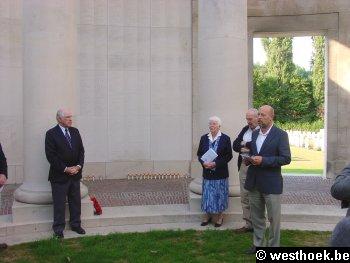
Het 8e bataljon DLI bleef in de Ypres Salient tot de 20e
juni, toen de divisie verplaatst werd naar de sector rond
Kemmel.
De periode in Kemmel verliep rustig en op 16 juli vertrok
het bataljon naar Armentières. Hier werden ze ingezet
voor routine opdrachten in de loopgraven, afgewisseld met
rustperiodes in en rond Armentières.
Op 8 en 9 augustus bemanden ze een loopgraaf in l'Epinette.
Henry White en zijn compagnie waren in de ondersteunende
loopgraaf. Ze werden bestookt door hevig vijandig vuur en
volgens de oorlogsdagboeken van het bataljon viel er slechts
één slachtoffer die nacht: Private H. White
van de 8th Durham light lnfantry.
"9.8.15: Monday. 6th DLI at Asylum, 8th in the
trenches. Soon after 2 am there was a very heavy bombardment
to the north. At 3.15 om Germans opened artillery fire
against our lines which lasted until 4.15 am. No damage
was done and we only suffered one casuatty, Pte White,
'A' Company. The rest of the day passed quietly."
Hij werd in de nabijheid begraven, maar door de hevige
beschietingen werd het graf vernield en Henry White heeft
geen gekend graf meer. Zijn naam is gebeiteld in het Ploegsteert
Memorial voor de vermisten.
Verwanten
Henry White huwde met Alice in 1910. Hun oudste zoon was
John, geboren in oktober 1913 en onze vader (grootvader)
Henry, werd geboren in november 1915, na de dood van zijn
vader. Henry's broer John, die ook als mijnwerker werkzaam
was vanaf zijn 12e, ging eerst bij het 8th Battalion Durham
Light lnfantry, maar werd daarna overgeplaatst naar het
2nd Battalion Yorks and Lans Regiment. Hij was in dienst
van zijn bataljon toen hij vermist werd op 13 oktober 1916
in Le Transly in de streek van de Sornme. Ook hij heeft
geen gekend graf en wordt herinnerd op het Thiepval Memorial.
Harry White, grandson of Henry White
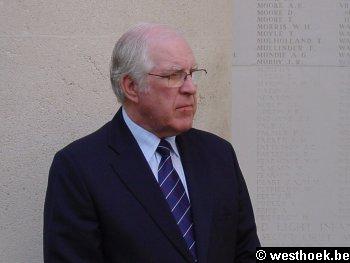
Mss Harry White
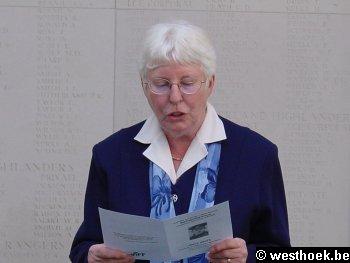
Private Henry White was born February 1891, at Greencroft,
County Durham. He was the second son of Annie and Ernest
White, a coal miner. Henry worked in the coal mines from
the age of 12. He joined the newly formed Territorial Defence
Force as a private soldier on 16th April 1908, aged 17.
He was 5'5" in height and served with 'E' Company at
the Drill Hall at West Pelton, near Chester-le-Street. His
service continued with the Territorials, training at weekends
and at annual camps until the declaration of war in August
1914, when his Battalion, with the Division, was calted
to arms and took up defensive positions along the north-east
coast of England. Training was intensified and re-equipping
took place until the Division was called to serve overseas
in April 1915.
The Battation arrived in Boulogne on the 20th April 1915
and moved to the Divisional Assembly Area around Cassel/Steenvoorde.
lt was intended that the Divisions should spend time there
training and preparing to join British units in the trenches.
However, on the 22nd April 1915, the Germans released a
poison gas in front of French troops to the north-east of
Ypres causing many casualties: the remaining troops came
under extra pressure and reserve units were called up to
plug the gaps. It soon became necessary to introduce infantry
units of the newly arrived inadequatety trained and inexperienced
Northumbrian Division.
At 0330 am on the 25th April the 8th Battalion, including
Private White, found themselves at Boetleer Farm on Gravenstafel
Ridge in support of beleaguered Canadian troops. Many casualties
were sustained in the heavy fighting until on the 26th April
the survivors were ordered to withdraw. At first count only
6 officers and 140 other ranks of the Battation arrived
at Verlorenhoek. Henry White was admitted to a casualty
clearing station on the 20th May for dental treatment and
rheumatism, returning to the Battalion on the 9th June.
The 8th Battation DLI continued to serve in the Ypres Salient
until the 20th June, when the Division moved to the Kemmel
Sector.
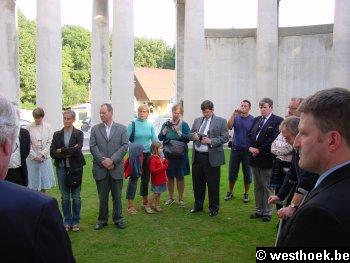
A period of service at Kemmel would seem to be uneventful
for Henry White before the Battalion moved to Armentieres
on 16th July. Here the Battalion undertook routine trench
duties interspersed with rest periods in and around Armentieres.
On the 8/9th August, the Battalion occupied trenches at
l'Epinette. Henry White and his Company were in the support
trench. They were subject to heavy enemy artillery fire,
and according to the Battalion War Diaries, the Battalion
suffered onty one casualty that night. This was Private
H White of the 8th Durham light lnfantry.
Extract from War Diaries 1 /8th Durham Light lnfantry
"9.8.15: Monday. 6th DLI at Asylum, 8th in the
trenches. Soon after 2 am there was a very heavy bombardment
to the north. At 3.15 am Germans opened artillery fire
against our lines which lasted until 4.15 am. No damage
was done and we only suffered one casualty, Pte White,
'A' Company. The rest of the day passed quietly."
He was reported to have been buried nearby but the grave
did not survive subsequent fighting over this area and Henry
White has no known grave. His name is inscribed and commemorated
on the Ploegsteert Memorial to the missing.

Family
Henry White was married to Alice in 1910. Their first son
John was born October 1913 and our father/grandfather, Henry,
was born in November 1915 after the death of his father.
Henry's brother John, who also worked as a miner from the
age of 12, joined initially the 8th Battalion Durham Light
lnfantry, but eventually was transferred to the 2nd Battalion
Yorks and Lancs Regiment. He was serving with this Battalion
when he was lost in action on the 12th October 1916 at Le
Transloy in the Somme Sector. He, too, has no known grave
and is commemorated on the Thiepval Memorial.

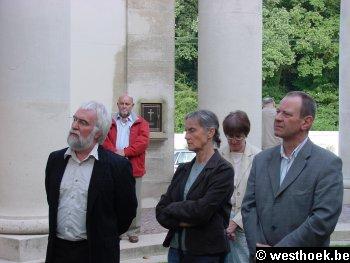

En het blazen van de Last Post door de klaroeners van de
Ieperse brandweer.
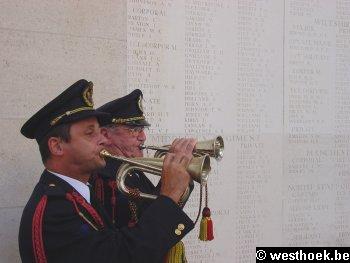
The Exhortation.
They shall grow not old, as we that are left grow old.
Age shall not weary them, nor the years condemn.
At the going down of the sun and in the morning.
We will remember them.
Neerlegging van een krans.
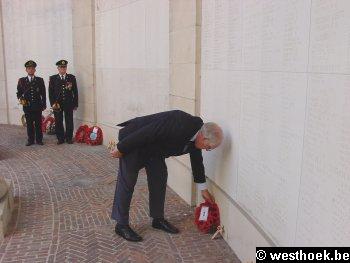
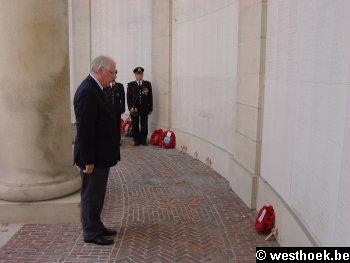

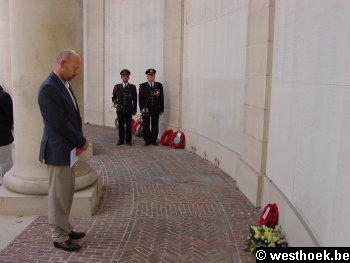
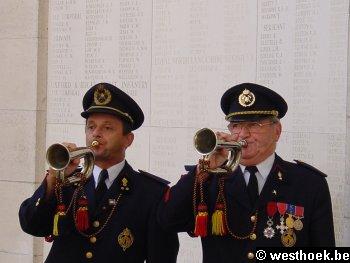
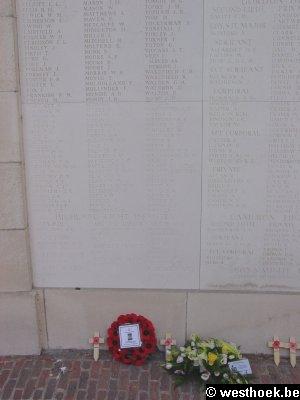
The panel with the name of Private Henry White.
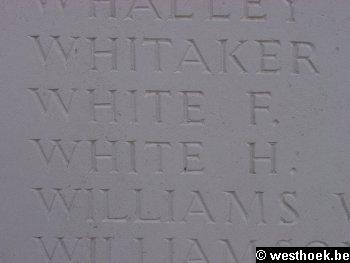
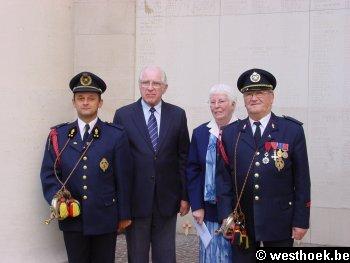
's Avonds woonde de familie nog de Last Post bij in Ieper.